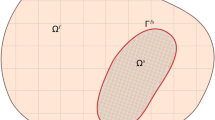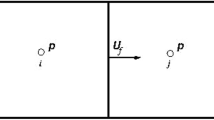Abstract
A stable and accurate Smoothed Particle Hydrodynamics (SPH) method is proposed for solving elastodynamics in solid mechanics. The SPH method is mesh-free, and it promises to overcome most of disadvantages of the traditional finite element techniques. The absence of a mesh makes the SPH method very attractive for those problems involving large deformations, moving boundaries and crack propagation. However, the conventional SPH method still has significant limitations that prevent its acceptance among researchers and engineers, namely the stability and computational costs. In approximating unsteady problems using the SPH method, attention should be given to the choice of time integration schemes as accuracy and efficiency of the SPH solution may be limited by the timesteps used in the simulation. This study presents an attempt to reconstruct an unconditionally stable SPH method for elastodynamics. To achieve this objective we implement an explicit Runge–Kutta Chebyshev scheme with extended stages in the SPH method. This time stepping scheme adds in a natural way a stabilizing stage to the conventional Runge–Kutta method using the Chebyshev polynomials. Numerical results are shown for several test problems in elastodynamics. For the considered elastic regimes, the obtained results demonstrate the ability of our new algorithm to better maintain the shape of the solution in the presence of shocks.
Similar content being viewed by others
References
Altomare C., Crespo A.J.C., Rogers B.D., Dominguez J.M., Gironella X., Gomez-Gesteira M.: Numerical modelling of armour block sea breakwater with smoothed particle hydrodynamics. Comput. Struct. 130, 34–45 (2014)
Arnold D.N., Lee J.J.: Mixed methods for elastodynamics with weak symmetry. SIAM J. Numer. Anal. 50, 2743–2769 (2014)
Ashby M.F., Jones D.R.H.: Engineering Materials 2. Elsevier, Amsterdam (2013)
Atluri S.N., Zhu T.: A new meshless local Petrov–Galerkin (MLPG) approach in computational mechanics. Comput. Mech. 22, 117–127 (1998)
Bui H.H., Fukagawa R., Sako K., Ohno S.: Lagrangian meshfree particles method (SPH) for large deformation and failure flows of geomaterial using elastic–plastic soil constitutive model. Inter. J. Numer. Anal. Methods Geomech. 32, 1537–1570 (2008)
Bui H.H., Fukagawa R., Sako K., Wells J.C.: Slope stability analysis and discontinuous slope failure simulation by elasto-plastic smoothed particle hydrodynamics (SPH). Geotechnique 61, 565–574 (2011)
Doring, M., Oger, G., Alessandrini, B., Ferrant, P.: SPH simulations of floating bodies in waves. In: Proceedings of the International Workshop on Water Waves and Floating Bodies (IWWWFB), Cortona, Italy (2004)
Dyka C.T., Ingel R.P.: An approach for tension instability in smoothed particle hydrodynamics (SPH). Comput. Struct. 57, 573–580 (1995)
Dyka C.T., Randles P.W.: Stress points for tension instability in SPH. Inter. J. Numer. Methods Eng. 39, 2725–2741 (1996)
Gingold R.A., Monaghan J.J.: Smoothed particles hydrodynamics: theory and application to non-spherical stars. Mon. Not. R. Astron. Soc. 181, 375–389 (1977)
Gomez-Gesteira M., Rogers B.D., Crespo A.J.C., Dalrymple R.A., Narayanaswamy M.: SPHysics development of a free-surface fluid solverpart 1: theory and formulations. Comput. Geosci. 48, 289–299 (2012)
Gray J.P., Monaghan J.J., Swift R.P.: SPH elastic dynamics. Comput. Methods Appl. Mech. Eng. 190, 6641–6662 (2001)
Hernquist L., Katz N.: TreeSPH—a unification of SPH with the hierarchical tree method. Astrophys. J. Suppl. Ser. 70, 419–446 (1989)
Hoover W.G., Hoover C.G.: Spam-based recipes for continuum simulations. Comput. Sci. Eng. 3, 78–85 (2001)
Kandilas C.B.: Transient elastodynamic analysis of nonhomogeneous anisotropic plane bodies. Acta Mech. 223, 861–878 (2012)
Landau L.D., Lifshitz E.M.: Theory of Elasticity, vol. 7, 2nd edn. Pergamon Press, Oxford (1970)
Libersky L.D., Petschek A.G., Carney T.C., Hipp J.R., Allahdadi F.A.: High strain Lagrangian hydrodynamics: a three dimensional SPH code for dynamic material response. J. Comput. Phys. 109, 67–75 (1993)
Liu G.R., Liu M.B.: Smoothed Particles Hydrodynamics: A Meshfree Particle Method. World Scientific Publishing, Singapore (2004)
Liu M.B., Liu G.R.: Smoothed particle hydrodynamics (SPH): an overview and recent developments. Archives of computational methods in engineering. Mon. Not. Royal Astron. Soc. 17, 25–76 (2010)
Lucy L.B.: A numerical approach to the testing of the fission hypothesis. Astron. J. 82, 1013–1024 (1977)
Mirzaei D., Hasanpour K.: Direct meshless local Petrov–Galerkin method for elastodynamic analysis. Acta Mech. 276, 1–14 (2015)
Monaghan J.J.: Simulating free surface flows with SPH. J. Comput. Phys. 110, 399–406 (1994)
Monaghan J.J.: SPH without a tensile instability. J. Comput. Phys. 159, 290–311 (2000)
Monaghan J.J., Lattanzio J.C.: A refined particle method for astrophysical problems. Astron. Astrophys. 149, 135–143 (1985)
Monaghan J.J.: On the problem of penetration in particle methods. J. Comput. Phys. 82, 1–15 (1989)
Monaghan J.J.: Smoothed particle hydrodynamics. Ann. Rev. Astron. Astrophys. 30, 543–574 (1992)
Morris J.P., Fox P.J., Zhu Y.: Modeling low Reynolds number incompressible flows using SPH. J. Comput. Phys. 136, 214–226 (1997)
Randles P.W., Libersky L.D.: Smoothed particle hydrodynamics: some recent improvements and applications. Comput. Methods Appl. Mech. Eng. 139, 375–408 (1996)
Randles P.W., Libersky L.D.: Normalized SPH with stress points. Int. J. Numer. Methods Eng. 48, 1445–1462 (2000)
Robinson M.: Turbulence and Viscous Mixing Using Smoothed Particle Hydrodynamics. Monash University, Clayton (2009)
Sellountos E.J., Sequeira A., Polyzos D.: A new LBIE method for solving elastodynamic problems. Eng. Anal. Bound. Elem. 35, 185–190 (2011)
Shao J.R., Li H.Q., Liu G.R., Liu M.B.: An improved SPH method for modeling liquid sloshing dynamics. Comput. Struct. 100-101, 18–26 (2012)
Srivastava, S.: Mixed discontinuous Galerkin methods: application to nonlinear elastodynamics. Ph.D. thesis in State University of New York at Buffalo (2008)
Takeda H., Miyama S.M., Sekiya M.: Numerical simulation of viscous flow by smoothed particle hydrodynamics. Prog. Theor. Phys. 92, 939 (1994)
Verwer J.G., Hundsdorfer W.H., Sommeijer B.P.: Convergence properties of the Runge–Kutta–Chebyshev method. Numer. Math. 57, 157–178 (1990)
Van der Houwen P.J.: Explicit Runge–Kutta formulas with increased stability boundaries. Numer. Math. 20, 149–164 (1972)
Van der Houwen P.J., Sommeijer B.P.: On the internal stability of explicit, m-stage Runge–Kutta methods for large m-values. Z. Angew. Math. Mech. 60, 479–485 (1980)
Vignjevic R., Reveles J.R., Campbell J.: SPH in a total Lagrangian formalism. Comput. Model. Eng. Sci. 14(3), 181198 (2006)
Violeau D., Leroy A.: Optimal time step for incompressible SPH. J. Comput. Phys. 288, 119–130 (2015)
Zhang A., Ming F., Cao X.: Total Lagrangian particle method for the large-deformation analyses of solids and curved shells. Acta Mech. 225, 253–275 (2014)
Zhang A., Sun P., Ming F.: An SPH modeling of bubble rising and coalescing in three dimensions. Comput. Methods Appl. Mech. Eng. 294, 189–209 (2015)
Author information
Authors and Affiliations
Corresponding author
Rights and permissions
About this article
Cite this article
He, L., Seaid, M. A Runge–Kutta–Chebyshev SPH algorithm for elastodynamics. Acta Mech 227, 1813–1835 (2016). https://doi.org/10.1007/s00707-016-1603-8
Received:
Revised:
Published:
Issue Date:
DOI: https://doi.org/10.1007/s00707-016-1603-8




